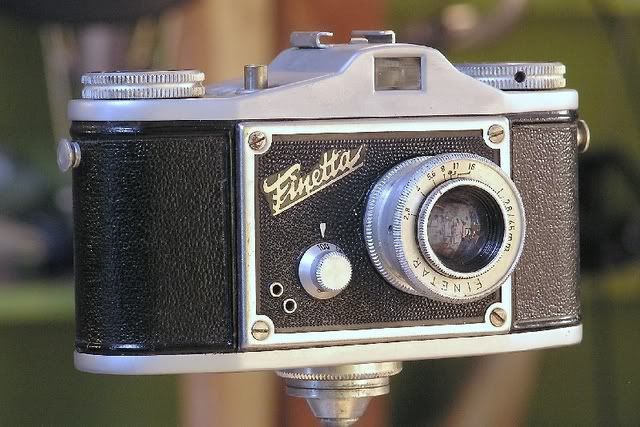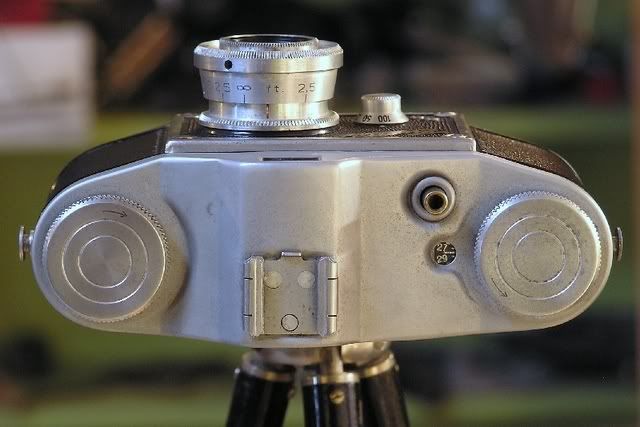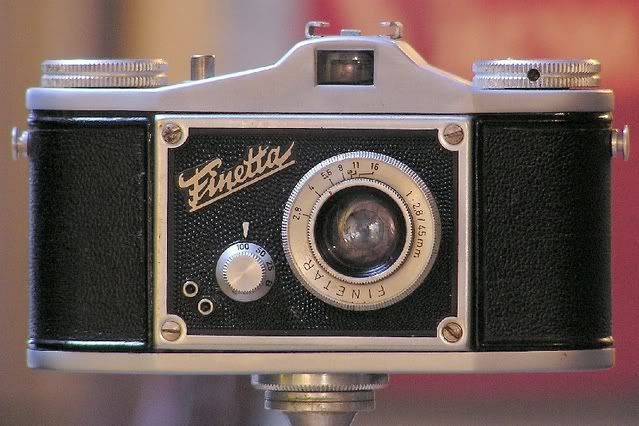|
|
Post by nikkortorokkor on Oct 26, 2007 1:09:09 GMT -5
This strange wee beastie came with the Flexaret that I managed to bugger up. I guess it's a consolation prize of sorts. I think that a lot of people are quite intrigued by expat Dutchman Piet Sarabier's cameras, which were produced in Goslar, Germany from 1947 until 1957, the factory having been bankrupted in 19576. There is certainly a bit of info flying round the Web about Finettas and their brethren. What I find most interesting is that the lens is interchangeable. This IV-D features a 27mm screw mount. Fancier models had bayonets. Yet no rangefinder was ever fitted. Scale focussing the f/6.3, 70mm Tele-Finettar (1 of 4 lenses available) must've been an exercise in faith! Mine came with the standard f2.8/45mm Finetar. The simple, 2 bladed guillotine shutter requires a fairly strong trigger finger. I reckon that the variable speeds (100, 50, 25 + B) are pretty academic, try as I might, I can't release the shutter without the squinty viewfinder jumping perceptibly upwards. I guess it's a product of muscular tension and a light body (the chassis is Bakelite). I'd be loath to shoot at anything under 1/100. So here you are, a ca1950 Finetta IV-D in all its weird glory.    |
|
|
|
Post by Just Plain Curt on Oct 26, 2007 5:34:06 GMT -5
Hi Michael,
While it must be annoying to have the Flexaret go kaput, I'd be happy as a clam to get this Finetta in the same deal. Wonderful little camera, seldom seen in these parts, in very nice shape. What seems to be wrong with your Flexaret anyway?
|
|
|
|
Post by nikkortorokkor on Oct 26, 2007 15:43:05 GMT -5
What seems to be wrong with your Flexaret anyway? The Flexaret II came to me very tatty, skin hanging off or missing, signs of fungus in the (uncoated) taking lens, flaking paint, sluggish shutter (a simple Prontor II) etc. I completely disassembled the camera & began to clean & paint. In the process I discovered the Flexaret to be very well made. The screws are much tougher than the typical Japanese fare. The chrome was thick and intact with no rust. Meopta confirms my positive bias towards Czech workmanship, formed by owning the iconic BRNO .22 rifle when a kid. Anyway, I got the shutter going nicely with a quick flood. Cleaned all the glass, redid the finish on the light alloy viewfinder housing. All went well until I went to reassemble the focussing mechanism, which is a massive helix much like that found on the typical FL rangefinder. Could I get it back together? I even tried freezing the male half to shrink it. No joy. I eventually lightly dressed the leading edge of the male half. Big mistake. It allowed me to start the thread just enough for it to jamb. In the process of unjambing, you guessed it, I distorted the male half. It'll never work now. The only way I can figure of getting the thing back together is to offer each half up in a lathe, turning the chuck by hand. I don't have a lathe. Lesson 1. Mepota's focus mechanism is VERY precisely machined. Buyer's can be assured that this thing will work accurately forever. Lesson 2. Never, never disassemble a working Flexaret helical focusing mechanism. I've performed this operation on Japanese rangefinders with little frustration, but the Flexaret? It beat me but good! Lesson 3. Take the hint and keep away from TLRs. The rangefinder gods were punishing me for straying. Back on topic. Finetta's best camera, the spring driven, bayonet mount 99 was marketed in the US as the Ditto 99. Some may have made it up to Canada? |
|
|
|
Post by Just Plain Curt on Oct 26, 2007 21:51:54 GMT -5
Ditto 99 huh? Hmmm, another to add to my search list. By the way, there's no way I'm taking apart my Flexaret now, LOL.
|
|
|
|
Post by nikkortorokkor on Oct 28, 2007 16:23:18 GMT -5
I'm not sure if you're laughing with me or at me, Curt. I do think that you are wise though, not to pull the Meopta to bits! It is all pretty straight forward except for that durned focusing helix!
McKeown states that 100,000 units were produced by Finetta, so something should turn up. In typical internet fashion, just after I got mine, another turned up on our local auction site, complete with case and manual. Cameras seem to travel in flocks!
Camerapedia also has a lot of useful info, including this on the genesis of the Finneta-Werk cameras: 'In 1947 a cooperation with Helmut Finke began. Finke had been former constructor at Voigtländer, Braunschweig.'
Maybe it is from Finke that the Italian sounding Finetta name was drawn. I find it quite interesting that German camera makers seemed to see a marketing cachet in Italian sounding names. Finetta is not the only Italian sounding German camera.
In the bicycle trade, which I worked in for many years, faux Italian brand names are very common, but one would have thought that German names would hold the greatest cachet in the camera market.
|
|
PeterW
Lifetime Member
   Member has Passed
Member has Passed
Posts: 3,804
|
Post by PeterW on Oct 28, 2007 17:30:00 GMT -5
Michael,
Don't know about the others, but Finetta (like Mercedes) is a girl's name. Maybe someone named it after a wife or daughter?
PeterW
|
|
|
|
Post by nikonbob on Oct 28, 2007 19:28:29 GMT -5
Micheal
Totally OT but close, I share your high regard for the BRNO rifles. I have several and think they are the equal of any production German rifle in terms of workmanship. The Czechs have good steel and know how to use it. I also have a Meopta rifle scope so I can guess how well built their cameras are. Sorry to hear the sad tale of the Flexaret II.
Bob
|
|
|
|
Post by Just Plain Curt on Oct 28, 2007 22:20:26 GMT -5
Hi Michael,
Laughing with you, never at you. Been there done that with too many cameras to ever chuckle at someone else's troubles. And I have to thank you for bringing this Finetta to my attention.
|
|
|
|
Post by nikkortorokkor on Oct 29, 2007 2:03:43 GMT -5
Well, that's interesting Peter. Saraber and Finke's first effort was actually called a Finette, which is, I find, also a girl's name. The Finetta name was used from about 1950, I think. Camerapedia or McKeown's will provide the exact date.
Camerapedia also supplies the knowledge that Piet was an electrical engineer and that his German factory began by making electrical components. This perhaps explains the rather skilful use of Bakelite. I know that Bakelite was used extensively in the budget end of the camera industry too, but I think that the Finetta is quite interesting in that the Bakelite was used internally and is disguised where it is visible (the 'leatherette' front plate is actually the Bakelite body with stipples moulded in so that it resembles leatherette). Perhaps Saraber and Finke recognized Bakelite's principle weakness when used in a camera, its relative brittleness and hence poor resistance to impact damage.
Bob, I'd gathered from your post on another group that you are also familiar with firearms. I know very little about Czech engineering except that both BRNO rifles and Jawa motorcycles are well regarded. It also makes me wonder: both the BRNO and the Jawa have been copied by Chinese factories (a BRNO 22LR magazine is interchangeable with one from a NORINCO 22LR), presumably due to some old Iron Curtain business deals. I wonder if any Chinese factories produced Meopta inspired cameras?
Curt, 'No Wurries Mate' as we say Downunder. The pain of the Flexaret has definitely been dulled by learning more about Saraber, something I'd never have done if I hadn't bought the job lot of cameras, & I'm glad if my experience has taught you a vicarious lesson. Learning from experience is often indelible, but not exactly as efficient as learning from someone else's experience.
Back to the viewfinder topic, Has anyone any experience with the DIAX IB? Surely the emperor of viewfinders, what with no less than 3 windows and interchangeable lenses. The same vendor who sold the Finetta has one on auction at the moment. I've been sorely tempted, but the chance of filling out my Paxette collection (someone has to love them) with a major purchase of lenses is helping me resist buying into yet another oddball system. Still, a fascinating camera.
|
|
|
|
Post by nikonbob on Oct 29, 2007 6:34:07 GMT -5
Micheal
I remember a highschool English teacher riding one of those Jawas to school in the late 60s. I hadn't realized that they were Czech made. I have seen and used Norinco rifles but they don't have the fit and finnish of the 50s and 60s Brnos. Then again later Brnos didn't have the fit and finnish either. I do know that there was a Chinese made copy of the M4, I think it was, so it is possible that there are Chinese made copies of Meopta cameras.
Bob
|
|
|
|
Post by nikkortorokkor on Oct 29, 2007 14:49:00 GMT -5
Bob, Jawa, CZ and ESO bikes all have a strong, cultish following, especially amongst fans of speedway and vintage motocross. I agree that the fit and finish of Norincos are nothing compared to genuine BRNOs, especially of the classic era. Mine is probably older than I am, and is beautifully made. As I wrote, the Flexaret immediately put me in mind of BRNO in terms of build quality.
It is interesting that the Czech optical, ordinance and motorcycle industries seemed to have managed something that eluded many Eastern Bloc concerns: consistent quality control (the infamous Skoda car might be another story).
|
|
PeterW
Lifetime Member
   Member has Passed
Member has Passed
Posts: 3,804
|
Post by PeterW on Oct 29, 2007 19:45:36 GMT -5
Michael,
Skoda, originally a bicycle and motorcycle maker, started making light cars quite early in the 1900s, and in 1924 started building the famous 6.5 litre overhead-camshaft Hispano-Suiza under licence. Then during the later 1920s and 1930s the company made some excellent cars of its own design, including a big eight-cylinder model, rated very high for quality.
During the war car production stopped, and Skoda made armaments. Car production started again in 1945 under communist control, but staff morale seemed to go to pieces. Design stagnated and quality control reached rock bottom, despite building a big new modern factory in 1964. Reliability was a joke. The kindest thing that could be said about Skodas was they they were cheap. But then so were Russian Ladas, basically Fiats built under licence. Not very refined, but they had rugged reliability.
Skodas became the subject of many jokes such as:
Q. Why has Skoda decided to fit heated rear windows?
A. So you don't get cold hands push starting them on cold mornings.
Q. Why does Skoda give a free squirrel with every car?
A. To collect the nuts that fall off.
Then with the collapse of 'Iron Curtain' and the communist bloc, things changed. Design, incorporating west-European technology, started to improve, and Skoda produced some works-modified saloon Rally cars that rather wiped the eye of an unsuspecting Ford and the Japanese teams, and notched up a series of first places. Perhaps this gave the production staff the morale boost they needed because quality also started to improve.
In 1991 Skoda was bought by Volkswagen, and new models using VW design and components have taken a further jump for the better. It's good to see a once highly respected name climb back again, even if they are basically VWs except for the body shells. They're still a lot less expensive than 'genuine' VWs.
PeterW
|
|
|
|
Post by nikkortorokkor on Oct 29, 2007 21:57:51 GMT -5
Peter, do you get the 'Hi, I'm Mavis' print media ads over there? A beautiful girl standing beside the latest VW Skoda says 'Hi, I'm Mavis', the byline is 'What's in a name?'
Skodas were imported to NZ in large numbers, and NZ assembled models were reputedly more reliable than the Czech versions. We also had the Nzeta, a local assembled version of the fantastically weird Czeta scooter, and there was even an abortive attempt at a locally designed car, a Tracker, which had a slab-sided faux Landrover fibreglass body and (I think) Skoda running gear. I can't rustle up any pictures on the net, Tracker is just too common a search name.
A favourite joke down here was 'what do you call a Skoda at the top of a hill? A bloody miracle!' A lot of the jokes were also applied to Ladas, but a local Lada salesman turned them into a marketing tool by beginning his radio ads with Lada jokes. That kind of irony applied to a Skoda would've just been cruel. In the 70d Skodas were particularly associated with Social Credit voters.
None of which has the slightest bit to do with viewfinder cameras.
|
|
|
|
Post by Randy on Dec 11, 2007 17:31:18 GMT -5
Very nice camera!
|
|
|
|
Post by cinedux on Dec 21, 2012 23:24:40 GMT -5
A recently aquired Finetta 99L in nice working cond.
|
|